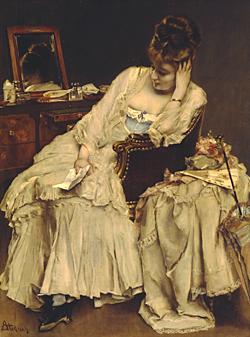
october 18, 2000–april 8, 2001
memories and regrets
This painting marks a shift within Stevens's work through its use of a particular model (Victorine Meurend, perhaps), who reappears in many paintings of the early 1870s, and by the new tonalities of the artist's palette. The subtle modulation of silvery grays and whites replaces the intense and often startling harmonies of the 1860s. Stevens was not a painter of the nude, but these scenes of an intimate toilette allowed him to explore aspects of the female body usually masked by the full regalia of formal dress worn in high society. The new gravity and even pathos of these melancholic figures were linked by some critics to the catastrophic political events of 1870-71, in which the Second Empire ended and the Paris Commune was defeated in the violence of a civil war. Stevens, a Belgian, had remained in Paris during the siege, volunteering to fight for the city. This painting was first owned by the distinguished American collector W. H. Stewart, who lived in Paris. Later it passed to the Peruvian poet Gabriel Yturri, who was the companion of Count Robert de Montesquieu, the model for Marcel Proust's Baron de Charlus in Remembrance of Things Past. In 1900 Montesquieu wrote a detailed analysis of Memories and Regrets that linked Stevens's painting with a Proustian sense of memory and of the relation of character to physical things, through which that character reveals itself and recalls its ladened past. From clues provided by the woman's rather unfashionable shoe and a slight heaviness of the skin in her face, Montesquieu identified her as a woman on the verge of middle age, wondering about her continuing allure to her lover in an age when men valued women only for appearance and youth. Stevens's model also prefigures Edith Wharton's character Lily Bart in The House of Mirth, who exposed the tragedy of women's longing for real affection in a world that saw them as glittering prizes.

